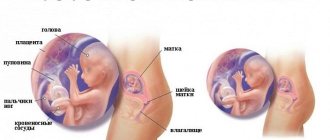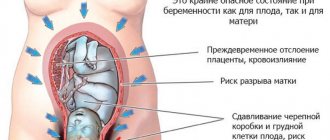Feelings of a woman at 34 weeks
The baby continues to grow and gain weight, and along with it, both the uterus and the pregnant woman’s belly grow. At week 34, the uterus measures up to 32 cm and is located 14 cm above the navel. It puts more and more pressure on the internal organs, which manifests itself in constant trips to the toilet, digestive problems (heartburn, nausea, constipation), shortness of breath and difficulty breathing.
At 34 weeks of pregnancy, the normal weight of a pregnant woman is +12 kg. If a woman has gained more, the doctor will advise how to reduce the intensity of weight gain. Extra pounds at this time will not lead to anything good; it will only be an additional burden on the spine and legs. For pregnant women with twins, the permissible weight gain is 14 kg.
Most expectant mothers at 34 weeks note that it becomes difficult for them to move, they quickly get tired of walking, and they are haunted by a constant feeling of heaviness in the lower back and legs. Some people can no longer put on their shoes without help. At this time, expectant mothers are recommended to do special physical exercises for pregnant women; you can sign up for gymnastics or yoga classes. Exercises will help reduce discomfort in the lower back, pelvis and leg pain.
At 34 weeks, the breasts increase in size and colostrum production begins. A hormonal surge occurs: the mother’s body begins to prepare for childbirth and subsequent breastfeeding.
If colostrum does not begin to be released, then there is nothing to worry about, because each organism is individual. Some mothers are afraid that if there is no colostrum, then there will be no milk. This is not true; for many, colostrum begins to be released only after childbirth, and after a couple of days milk arrives.
The approaching birth brings corresponding changes to the woman’s body: the pelvic bones diverge, which causes pain in the expectant mother. The amount of amniotic fluid increases, its volume reaches 1 liter. From the beginning of the 34th week of pregnancy, Braxton Hicks contractions become more frequent. When they appear, the woman feels pain in the upper abdomen, which, spreading throughout the entire uterus, gradually subsides. Such training contractions are necessary to prepare the body for the upcoming birth, which is only a few weeks away. There is absolutely no need to worry about them.
Edema, leg cramps, and the development of varicose veins are still possible. If swelling is severe, a woman should consult a doctor.
What's happening to the baby?
At this time, the fetus is already developed. There are cases when women give birth at this stage, and the child born is not considered premature, but born prematurely. He is quite viable, can breathe on his own and does not need special care.
At 34 weeks of pregnancy, the amount of lubricant that covers the baby's body increases. Now it protects him from the effects of amniotic fluid, and in the future it will help him pass through the birth canal more easily.
The development of the fetus is completed, its weight at 34 weeks already reaches 2-2.2 kg, and its height is 40-44 cm. At this stage of pregnancy, hair begins to grow in the child, replacing the fluff. The baby needs calcium, which he should receive from his mother.
Fetal movements at 34 weeks
The mother begins to feel the movement of the baby inside the womb at 18-22 weeks of pregnancy; by 25-27 weeks the baby’s movements are felt most clearly, sometimes causing the mother inconvenience and even pain. By the 34th week of pregnancy, the baby becomes large, and its movements are limited by the placenta. Changes in the baby's behavior are noticeable, but you should not be afraid of a decrease in his activity. Fetal movements at this stage become smoother. A pregnant woman should listen to the movements of her baby; they should be regular and daily, although not as active as in earlier stages.
Frequently asked questions on the forums
1:
Q: Why does my stomach become hard at 34 weeks?
A: The abdomen can become hard for several reasons: uterine hypertonicity or training contractions. Uterine tone can cause premature birth, while false contractions are absolutely safe. With increased tone, the lower abdomen remains hard for a long time; this sensation may be accompanied by pain in the lower abdomen and lower back. In this case, you need to consult a doctor, he will prescribe medications that reduce tone. During Braxton Hicks contractions, the abdomen becomes rigid for a short time; in most cases, such contractions are accompanied by unpleasant sensations in the lower abdomen, but women do not experience obvious pain.
2:
Q: What should be the CTG norms at 34 weeks of pregnancy?
A: The CTG standards are as follows:
- BHR (heart rate) – 110-160 beats/min (quiet state of the fetus) and 130-190 beats/min (active state of the fetus).
- Heartbeat rhythm (height of deviations from heart rate) – 5-25 beats/min.
- Increase in heart rate - from 2 beats in 10 minutes.
- Decreased heart rate - no.
- Uterine activity - no more than 15% of contractions from the heart rate, duration - no more than 30 seconds.
Cardiotocography is deciphered using a point system. Each of the above criteria is scored from 0 to 2 points. Based on the final assessment, we can talk about the condition of the fetus: 8-10 points – normal; 5-7 points – oxygen starvation of the fetus, without threats, repeat CTG is recommended; 4 points or less – severe fetal hypoxia, emergency delivery is recommended.
3:
V.: At 34 weeks my stomach dropped. This is fine? Is not it too early?
A: In the first pregnancy, the stomach very often drops 3-4 weeks before birth. Thus, drooping of the abdomen at 34 weeks is normal. With the second pregnancy, the belly drops, as a rule, later, 1-2 weeks before birth.
Why take it and how to prepare?
At the 33rd week of pregnancy, an ultrasound is performed to determine whether the fetus meets developmental standards and to exclude pathologies of the placenta.
There are 2 ways to conduct an ultrasound examination: transabdominal, when the doctor moves the device over the abdomen, and transvaginal, when the device is inserted into the pregnant woman’s vagina. If the vaginal method is preferable at the very beginning of pregnancy, then in the second and third trimesters the abdominal method is most often used.
No special preparation is required for it - the role of a filled bladder is played by amniotic fluid. If cervicometry is required, i.e. examination of the cervix, or clarification of the parameters of the fetus and uterus; in addition, the doctor can conduct research with a vaginal sensor (transducer).
Is it harmful?
Experts believe that moderate use of ultrasound does not harm the fetus and the body of the expectant mother. All concerns about the negative impact of the device on the child remain at the level of speculation. In terms of the degree of danger, a standard urine test and routine ultrasound are on the same level.
Refusal of a routine examination can complicate the work of doctors, and a pathology not detected in time can threaten the life of the unborn child and the normal process of pregnancy.
Tests and ultrasound at 34 weeks
At 34 weeks of pregnancy, you must undergo a routine examination by a doctor, take general blood and urine tests. During the examination, the gynecologist will measure the weight and abdominal circumference and compare the patient’s weight with previous ones. If the patient has gained a lot of weight and has severe swelling, she may be admitted to the hospital.
The woman will also have to undergo a routine ultrasound if this has not been done before. The specialist determines the position of the fetus, the condition of the placenta and the approximate size of the child. In 94% of cases, the child is positioned correctly in the womb - with the head towards the birth canal, and only in 6% of cases the fetus is positioned with its legs down. In the case of breech presentation, doctors note that delivery should be carried out by caesarean section. However, about half of the babies from these 6% will take the correct position before 36 weeks.
At 34 weeks of pregnancy, a gynecologist can determine the following disorders:
- placental abruption (symptoms include bleeding, muscle tension in the uterus and rapid heartbeat);
- hematoma on the uterus (it makes itself felt by pain in the lower abdomen, bleeding, low blood pressure);
- polyhydramnios (the expectant mother has high blood pressure, may have diabetes, the baby’s heartbeat is difficult to hear);
- oligohydramnios (its signs are dry mouth of the woman, nausea, weakness, smaller volume of the uterus compared to the norm).
Ultrasound norms at 34 weeks
Fetal size (normal)
| Index | Meaning |
| BPR (biparietal head size) | 79-93 mm |
| LZR (fronto-occipital head size) | 101-119 mm |
| OG (head circumference) | 295-339 mm |
| AB (abdominal circumference) | 276-336 mm |
| DG (length of shin bones) | 54-64 mm |
| DBL (femur length) | 65-70 mm |
| DP (humerus length) | 55-65 mm |
| DPP (length of forearm bones) | 48-55 mm |
| Height | 41-45 cm |
| Weight | 2-2.5 kg |
Amount of amniotic fluid
| Amniotic index | 72-274 |
Cervix
| Neck length | not less than 30 mm |
| Internal and external pharynx | closed |
Placenta
| Position | at least 7 cm from the cervix |
| Maturity level | I or II degree |
Why do an ultrasound at 33 weeks?
Some careless expectant mothers may think: if pregnancy up to 33 weeks progressed within normal limits, and your health was excellent, why contact doctors in the later stages? And indeed, in most cases, no pathology will be detected, and a study of the pregnant woman is prescribed to be on the safe side. But, unfortunately, in the third trimester, after 28 weeks, most serious complications develop, and most often the pregnancy is terminated.
An ultrasound at 33 weeks is an absolutely safe and uncomplicated examination for both the expectant mother and the baby. But it is precisely this that will help identify a number of serious problems, such as:
- intrauterine growth retardation;
- oligohydramnios or polyhydramnios;
- premature maturation of the placenta;
- developmental defects in a child (as a rule, at such a time it is possible to detect pathology of the cardiovascular system);
- umbilical cord entanglement;
- pathology of the mother's birth canal (for example, uterine fibroids, which are less visible in early pregnancy).
Of course, the vast majority of expectant mothers are not diagnosed with any of the above. But even in this case, ultrasound examination is not a waste of time! After all, the specialist will have to evaluate the following normal indicators in the pregnant woman and child:
- degree of maturity of the placenta;
- condition, length of the umbilical cord and the number of vessels in it;
- presentation and position of the fetus in the uterus;
- amount of amniotic fluid;
- cervical length.
And of course, during the ultrasound, the expectant mother will be told the sex of her baby (if this has not happened before). At this time, the possibility of error is practically eliminated! For most families, this is the most exciting question during pregnancy.
Even if all indicators assessed by ultrasound are within normal limits, the pregnant woman will be sent for CTG. This study allows you to evaluate the relationship between fetal heartbeats and uterine contractility over a period of time. If all is well, the expectant mother will have to wait for the birth and visit the local gynecologist as usual: after the third ultrasound, ultrasound examinations are no longer performed. If something alerts the specialist, the pregnant woman will be referred for additional examinations.
What should mom do?
Nutrition for pregnant women
Proper nutrition is the key to the health and well-being of mother and child. At week 34, the baby needs calcium, therefore, the expectant mother is recommended to consume more food containing this element:
- all dairy products (hard cheeses, cottage cheese, yogurt, sour cream, milk, fermented baked milk and others);
- vegetables (white and cauliflower, parsley, celery, garlic, peas, beans);
- berries (figs, cherries, strawberries);
- fish (sardine, salmon, carp, etc.).
It is better to eat food in small portions. The number of such receptions can be about 6-7 per day. During breaks, you can satisfy your hunger with berry fruit drinks, fresh fruit or a light salad of fresh herbs.
Preparing for childbirth
At 34 weeks of pregnancy, it is worth deciding on the choice of maternity hospital and doctor. The emergency bag that the mother will take with her to the maternity hospital should already be packed. Depending on the conditions of the maternity hospital, the list of necessary things may differ.
An approximate list of things to take to the maternity hospital is:
- documents (passport, policy, exchange card, birth certificate, results of the latest ultrasound);
- 2 shirts, robe, underwear, slippers;
- postpartum pads;
- toilet paper;
- dishes (plate, spoon, fork, mug);
- personal items (phone, charger, cosmetics, shampoo, etc.);
- things for the child (sheets, vests, blankets, caps, diapers, wet wipes).
Intimate life
After 34 weeks of pregnancy, sex is not recommended. Sex carries a certain risk for the fetus in late pregnancy. There is a high probability of infection in a woman’s birth canal. There is also a possibility that sex can affect the baby's position in the uterus. Having previously taken the correct position with his head down, the baby can roll over and sit on his butt.
In the question of whether it is possible to have sex in late pregnancy, an important factor is the course of the pregnancy itself. If no abnormalities are found in the expectant mother, and the gynecologist gives permission, then you can be sexually active. If a married couple nevertheless decides to have sex at this time, then the movements should be leisurely and smooth, and the position should be as comfortable as possible for the woman.
Video:
Mother's feelings in the last month of pregnancy
The state of health of the expectant mother at this time cannot be called ideal. Her spine is under serious stress, and her large belly often interferes with her ability to move. During this period, the woman gains about 12 kilograms in weight. It becomes especially difficult to fall asleep, since a rounded and raised belly slightly depresses the functioning of the lungs. Often women have the feeling that they just can’t breathe. Although this is rewarded with very beautiful and interesting dreams, since the nervous system is in an excited state. Doctors do not recommend resting on your back during late pregnancy, because in the final period of pregnancy in this position the uterus can put pressure on the abdominal aorta, leading to fainting.
The uterus also puts intense pressure on the bladder, so the expectant mother runs to the toilet even more often than at the very beginning of the term. At this time, the circulatory system of women works at full capacity, because more than 5 liters of blood circulate through it. Fortunately, at this time the normalization of red blood cells occurs, due to which anemia disappears. Hormones also work in an enhanced mode, provoking the production of colostrum.
It is especially worth noting the increased appetite, and this is the norm. But sometimes the expectant mother cannot control it, and uncontrolled consumption of lunch portions leads to weight gain. If you don’t want to painfully lose weight after childbirth, you don’t need to give up food under any circumstances. You just need to eat 7 times a day, but in small portions, and exclude flour and sweet foods rich in carbohydrates from your diet.
Some consequences of pregnancy can stay with a woman forever. For example, stretch marks. They appear when the skin on the abdomen is not elastic and dry. Therefore, especially in late gestation, it needs to be moisturized and softened with various cosmetics and oils. If your stomach starts to itch, this is a sure sign that it will soon be covered with stretch marks.










